There is a new plane in the sky, and you will be flying it from Delhi, Mumbai or Bengaluru next year when IndiGo lays its hands on it.
The Airbus A321XLR (eXtra Long Range) is the world’s longest-range single-aisle commercial aircraft, with a range of up to 4,700 nautical miles (slightly over 5,400 miles). This jet will open up new possibilities for mid- and long-haul travel, particularly on air routes with up to 200 – 220 passengers per flight.
I’ve been closely following the progress of this jet since 2019, when it was first announced. I truly believe this could be just the right jet to bring more point-to-point connectivity to the market and take away the load from some airline hubs.
Spanish airline Iberia is the launch customer of the new jet. It received the first of eight A321XLRs it has on order from Airbus at the end of October 2024 and will get the remaining jets over the next 15 months. Over 500 of these jets have been ordered, and the largest customer of the plane for now is IndiGo, with 69 on order.
Iberia has been operating familiarisation flights within Europe for the past week with the jet. The plane operated its first long-haul flight from the Adolfo Suárez Madrid-Barajas Airport in Madrid (MAD) across the Atlantic to Boston Logan International Airport (BOS) on Thursday, November 14, 2024. I was on board to try out Iberia’s all-new airplane, in the economy cabin, because that is where all the action and the concerns would be.
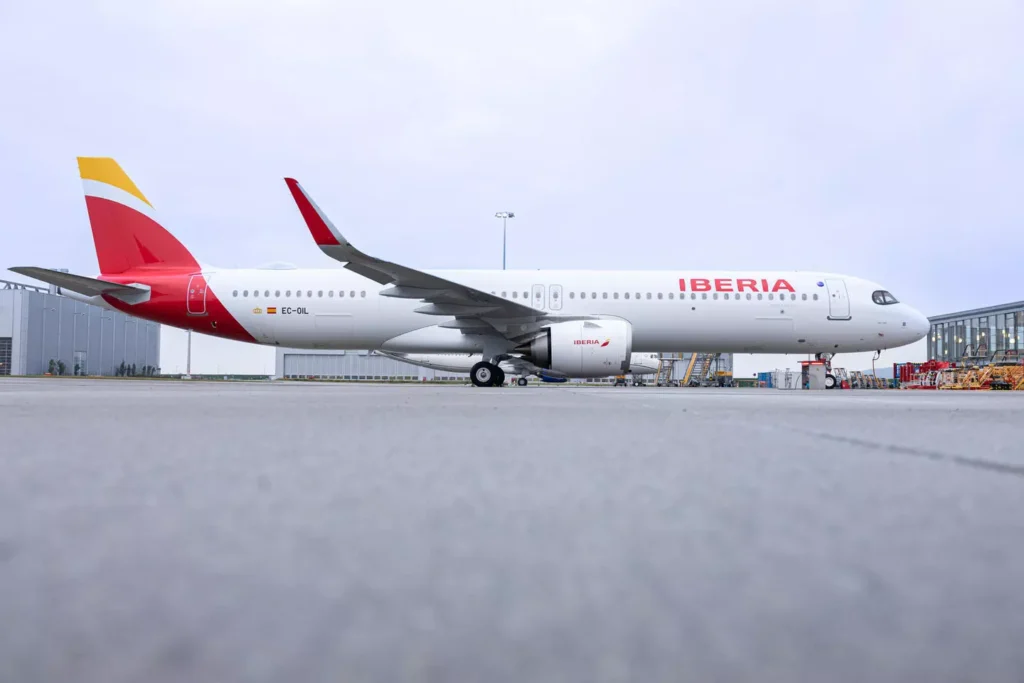
Iberia’s A321XLR at Hamburg before Delivery Flight
I’d booked my flight from Madrid to Boston on Iberia’s A321XLR in July 2024, when the launch date was set for the A321 to take over the route. And because these things may or may not always work out as per plan, I booked some placeholder bookings (that could be freely cancelled, if needed) to get into Madrid in time for the flight. Fortunately, that moment never came.
Here is what the experience was like and what we can all expect on board.
About the Airbus A321XLR
The new XLR variant of the A321 has a range of 4,700 nautical miles, which is longer than any other narrow-body aircraft. Airbus achieved this range by adding a third fuel tank at the back of the aircraft (called the Rear Center Tank), which gave it a 15% bump on the range from the A321LR variant (which can fly a maximum of 4,000 nautical miles).
The Boeing 757, the erstwhile narrowbody jet (now out of production), could fly far. Its -200 variant had a maximum range of 3,900 nautical miles. Because of its appearance, the nickname “The Flying Pencil.”

The aircraft’s 4,700-nautical-mile range from major Indian Centres. GREAT CIRCLE MAPPER
As you can see, the XLR could be a game changer for airlines that buy it. IndiGo has had frequent trouble with the A320neo on flights to Istanbul, which is just 2800 miles. With the XLR, the airline can fly deep into Europe, Africa, Asia and Australia without thinking twice. However, it will still be a while before an airline thinks of flying to the edge of the envelope of this aircraft.
The other use case for airlines is also to address the seasonality issue. Some routes are operated for only half a year or with subpar loads throughout the year because traffic patterns demand them. With the XLR arriving on the scene, airlines should be able to swap out widebodies for narrowbodies when the load reduces and operate some routes year-round by switching to the right aircraft at the right time.
For instance, for Iberia, destinations such as Boston and Washington DC, this is the problem they are trying to solve for now. Iberia can now put the A330/A350 during the summers (with 292 seats) and switch to the A321XLR during the non-peak seasons (with 182 seats). It could also look at flying 2x with the XLR over once a day with the A330neo. So, frequencies can be built up using the XLR.
While I wrote an article earlier this week talking about the airlines that have different plans for the XLR, it will be interesting to note that WizzAir will fly it with an all-economy-dense configuration. Qantas will fly it as a replacement for the 737. Closer home, IndiGo has already launched its journey towards a premium product with IndiGo Stretch and will almost certainly have a dual-cabin configuration on the A321XLR.
Iberia’s A321XLR Configuration
In business class, Iberia has installed 14 Thompson Aero Vantage Solo seats in a 1-1 herringbone configuration in the front of the aircraft. These are the same seats that JetBlue uses on its A321LR aircraft to fly between Boston and London/Amsterdam. Iberia skipped the doors, though.

Business Class on board Iberia’s A321XLR
These seats recline to lie-flat beds and offer direct aisle access, including a window so that one can watch outside. The window part is essential because other airlines used to trade window alignment for more seats.
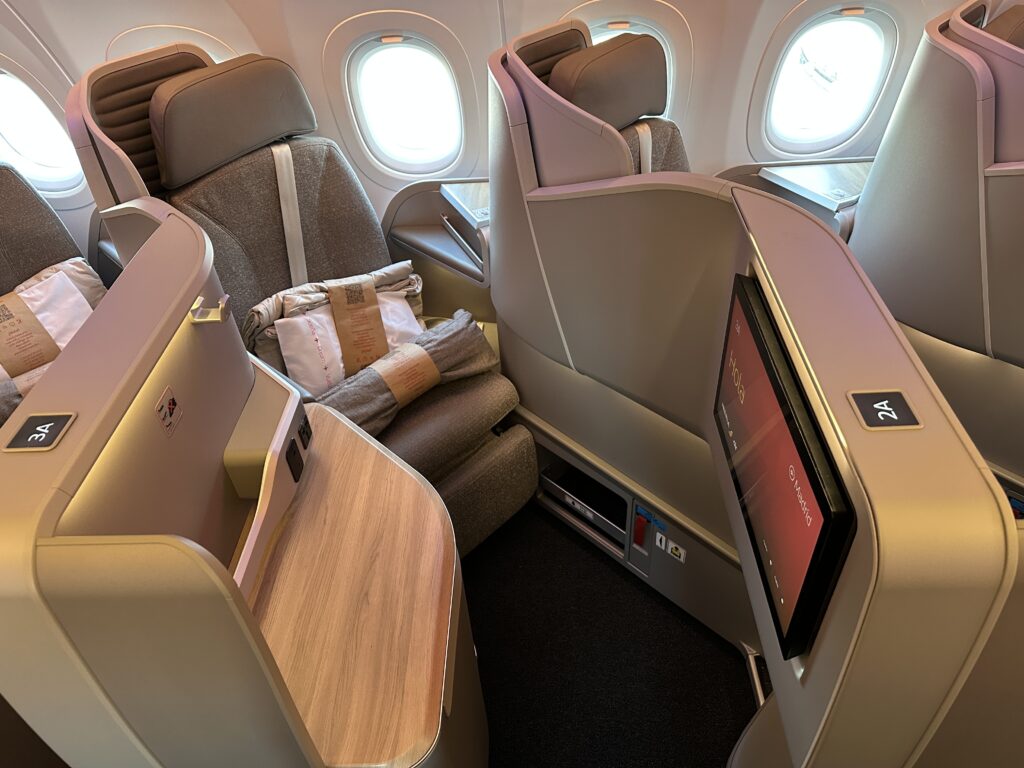
Business Class on board Iberia’s A321XLR
I tried one of these seats for a minute and a half, which was pretty comfortable, even for a broad fellow like me. Turns out these seats are 23 inches wide. There was also enough space to move around and sleep on the side. Many storage options are hidden all over the place, but you don’t immediately see them at eye level.
USB-A and -C charging ports and a universal power plug are also installed alongside the armrest for those who need to keep their devices and laptops charged. The airline also provided bedding, including a mattress topper, a pillow and a quilt.
The seats in Economy, where I was travelling, were more in number and smaller (obviously). The seats installed are Recaro’s R3, formerly known as the CL3810, which is the platform for long-haul flights from the seat manufacturer.
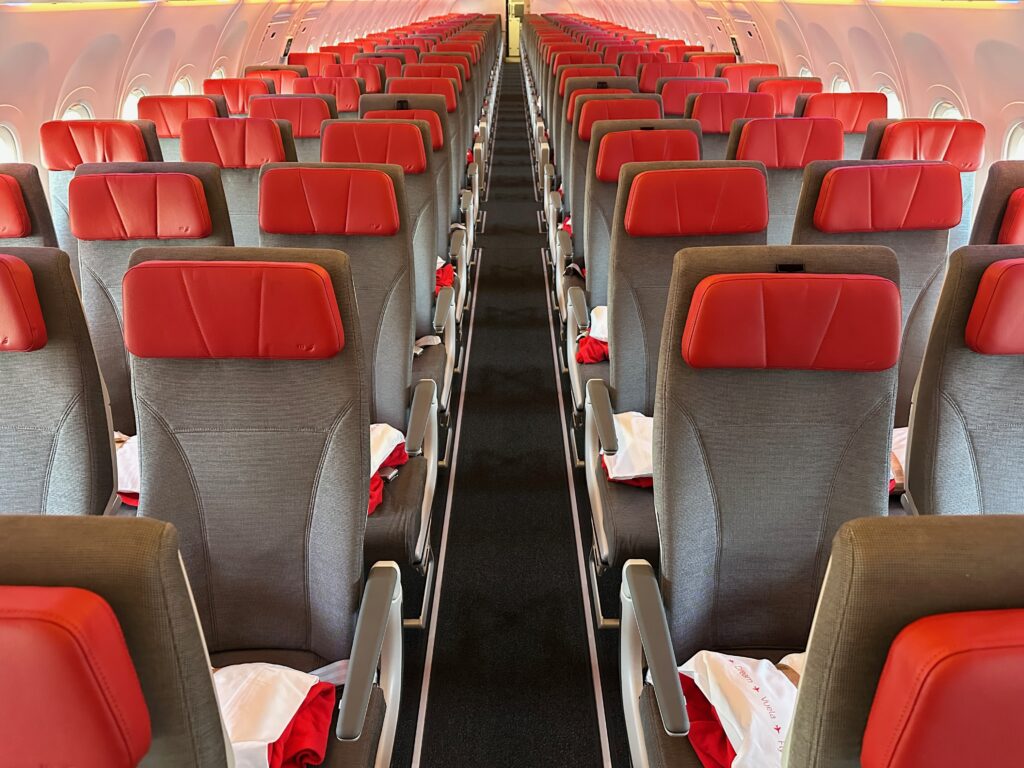
Economy (Tourista) Class onboard Iberia’s A321XLR
The airline did a good job, I believe, configuring the 3-3 layout with a 30″ seat pitch. The seats also reclined 4 degrees to the back, which I admired because sometimes that is just the recline you need to feel comfortable to catch a nap.
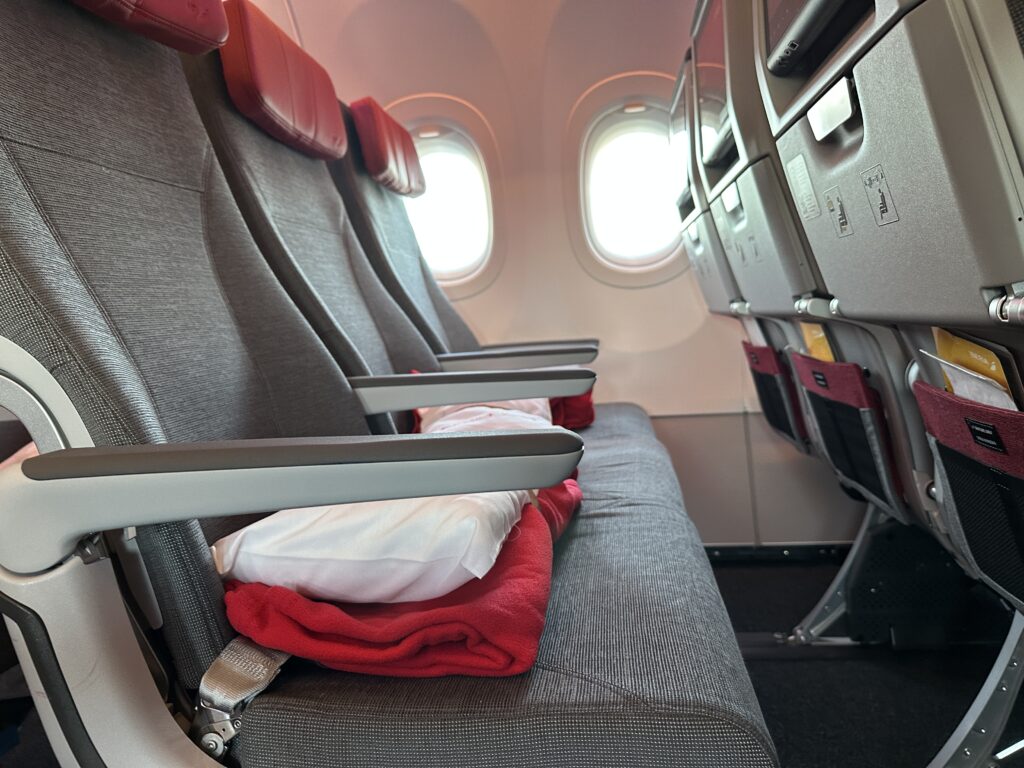
Economy (Tourista) Class Legroom onboard Iberia’s A321XLR
Unfortunately, I couldn’t be entirely selfless and sit in the middle seat. My oneworld Sapphire status unlocked the front row window seats (21A) with a larger pitch, about 40″. The IFE Screens, installed by Panasonic, were mounted on the wall rather than in the seatback.
A blanket and a pillow were waiting when I arrived at my seat. Panasonic and Iberia also provided goodie bags containing key chains and wireless earphones. These were conversation starters for many people who did not realise they were on a new aeroplane but now knew.
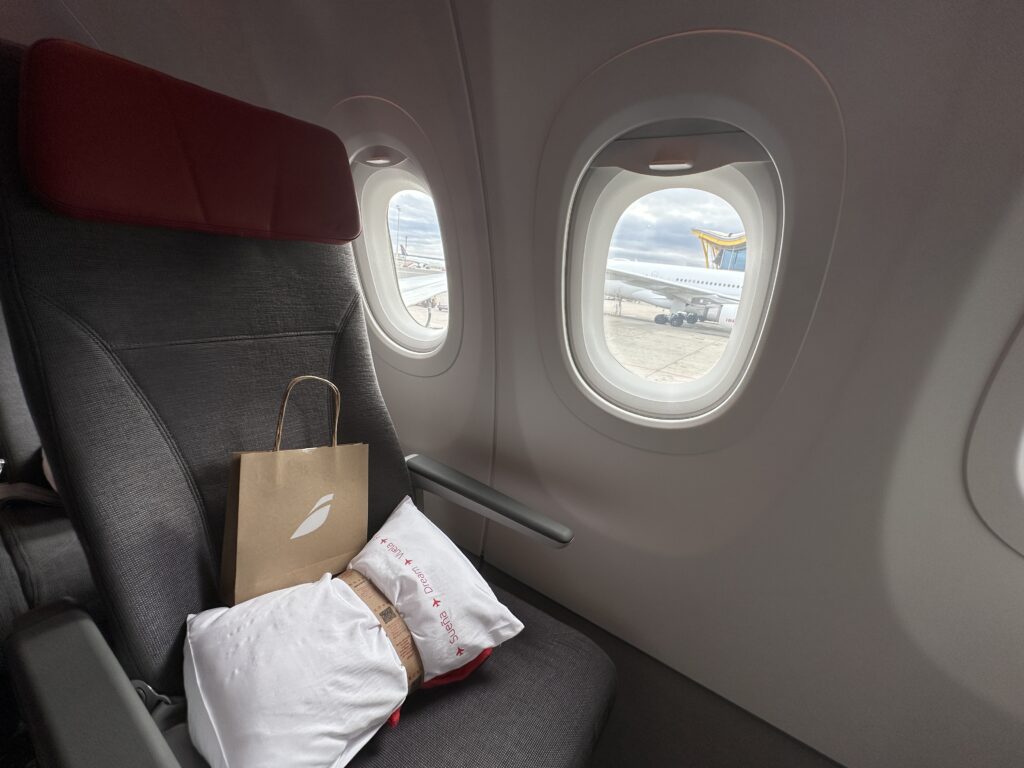
Economy (Tourista) Class onboard Iberia’s A321XLR
We pushed back on time from Madrid and were told to look out for a fire tender giving us a salute. I expected a traditional water cannon, but all I saw were two fire tenders, and we just passed by. The captain came again on the PA system and reminded everyone about how historic this flight would be, given the occasion of the first crossing of the XLR over to the USA.
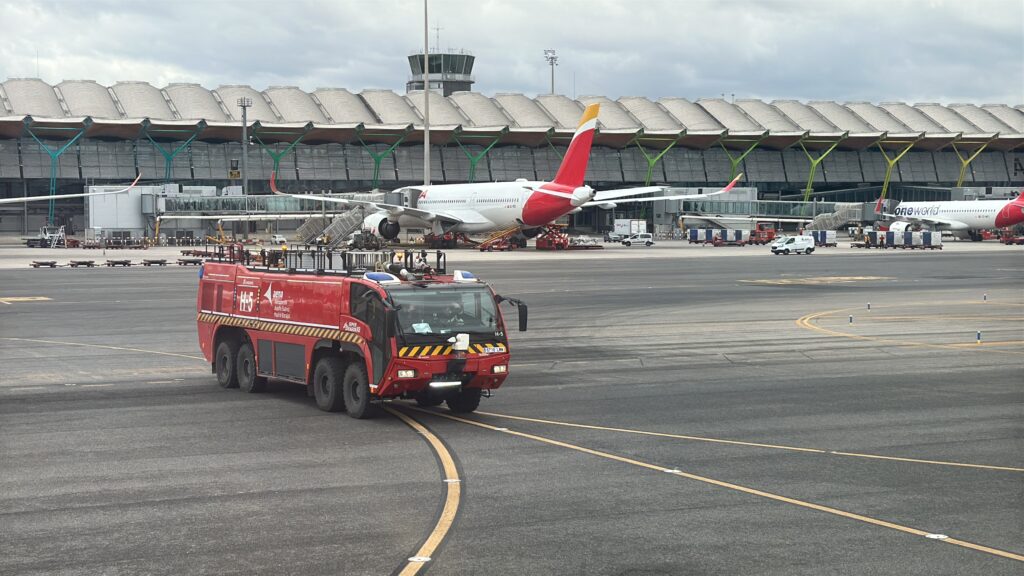
Fire Tenders for a (dry) Water Cannon Salute to the A321XLR’s first crossing across the pond
Then, with a quiet roar of the CFM LEAP 1A engines, we flew away for our eight-hour-long flight to Boston Logan Airport. The flight was over 90% full, which is excellent for a day 1 service and a testament to this being the right plane for the route.
Iberia’s A321XLR Service
Iberia only brought along training captains on this flight to operate the first flight. And similarly, they only brought along senior pursers to be the crew on board this flight. That would signify good service on board for the first flight.
I paid for my internet connection to put it to the test; however, as we left Spanish territory, the internet connectivity vanished, never to recur for the duration of the flight. As of the time of writing this article, a refund has yet to be issued. I then turned my attention to the 4K resolution screen in front of me, loaded with fantastic content in languages from both sides of the pond. I did not have any problem selecting movies to watch, and I watched two throughout the flight.
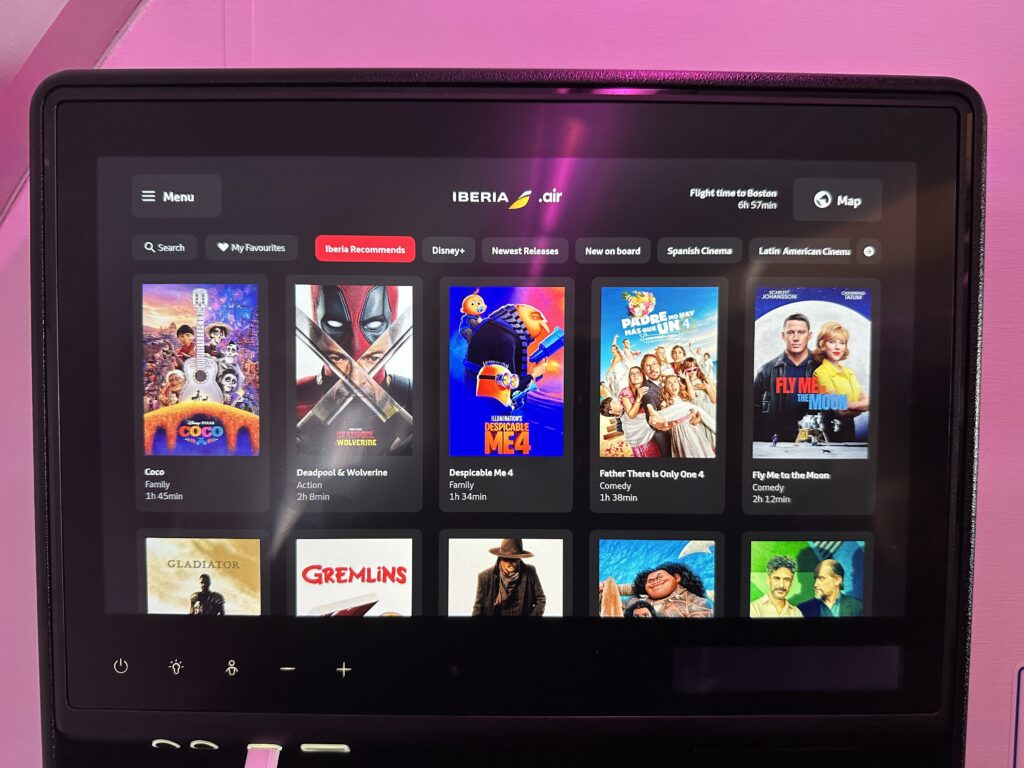
Iberia’s 4K Resolution IFE Monitors in Economy
Unfortunately, the ability to pair Bluetooth headsets was also buggy. A Panasonic engineer was on board, and he helped reset screens when they would bug out. The Iberia crew came around and handed me disposable wired headphones, which I used for most of the flight. I hope this will be smoothened out over time.
As we settled into the rhythm of this flight, the cabin crew brought out the beverages trolley. We had wines, beers and juices, but no Spanish kava. I settled for a white wine.
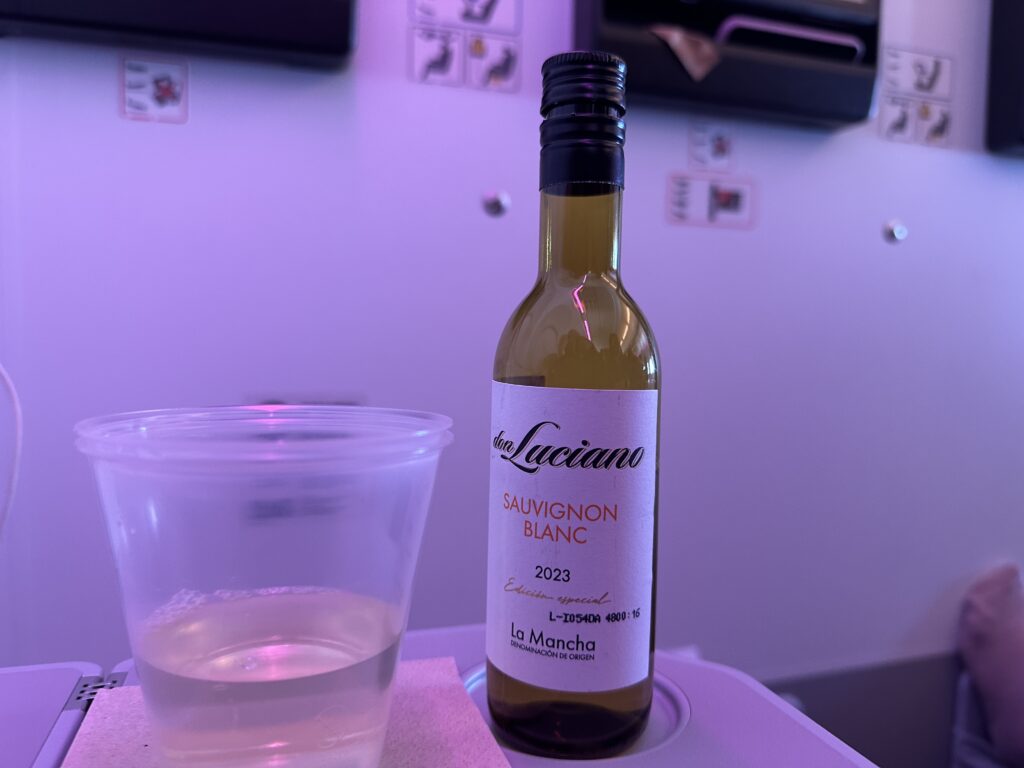
Iberia’s Beverage Service
A little later into the flight, meal service began. Iberia uses the services of the widely revered “Do & Co” catering company, and they did not disappoint.
Options on the flight included Pasta and a Burger Patty with Potato Mash. I went for the Pasta, and it was warm and delicious. Along with the Pasta, a salad and a lemon cake were on the tray. No bread was served, but instead, we got crackers.
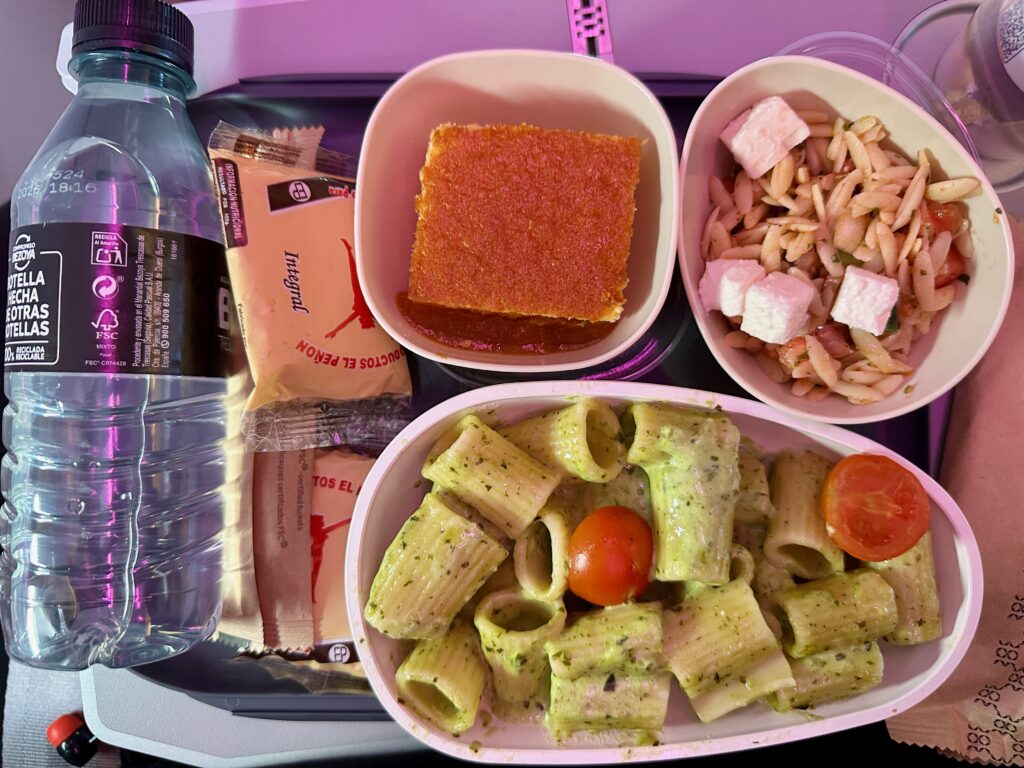
Iberia’s Lunch Service onboard flight to Boston
Service on board was quick, apart from being genuinely warm. After the meals, the crew came around for a tea and coffee service and swiftly made clearance.
During the mid-stage of the flight, the crew brought Magnum ice cream to everyone. There were no packaged snacks if you needed more food; instead, I saw pie being served in the galley. In European airline fashion, the only water bottle we got was brought along with the meal, and for the rest of the flight, we had to go back into the galley and ask for a cup of water.
The second meal service began about 1.5 hours before the flight’s landing. It consisted of a packaged ham sandwich served with chocolate and beverages.
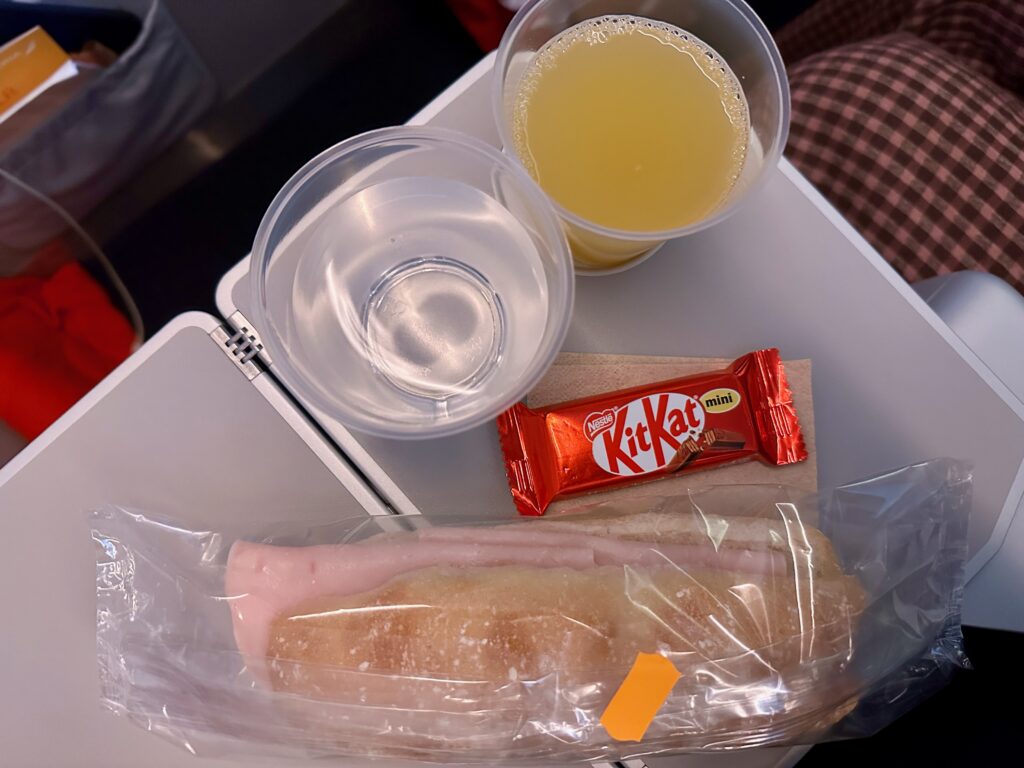
Iberia’s Quick Pre-Arrival Meal Service onboard flight to Boston
The galley and lavatory situation need their own discussion. Iberia chose a galley layout called the Airbus Space Flex, where half the space at the back of the plane is a galley, and the other half is turned into two lavatories, just like on the A320neos. That means there is only limited oven space to store food for this long flight. Once the airlines extend the flights to a 9-10 hour range and feel the need to serve a second hot meal, will they have enough space to store that second hot meal?
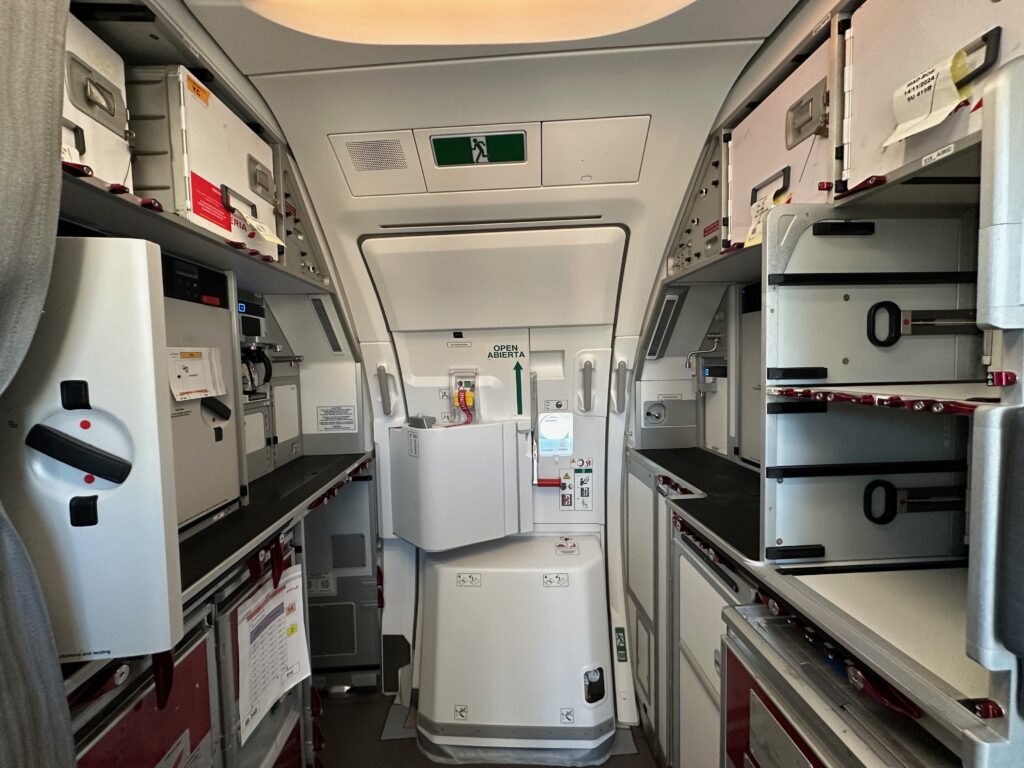
Galley for Iberia’s A321XLR
There are no lavatories in the middle of the airplane and only three in the back (including two from the galley’s carve-out). That means people would crowd at the back of the plane to use the lavatory and squeeze over each other to get to it.
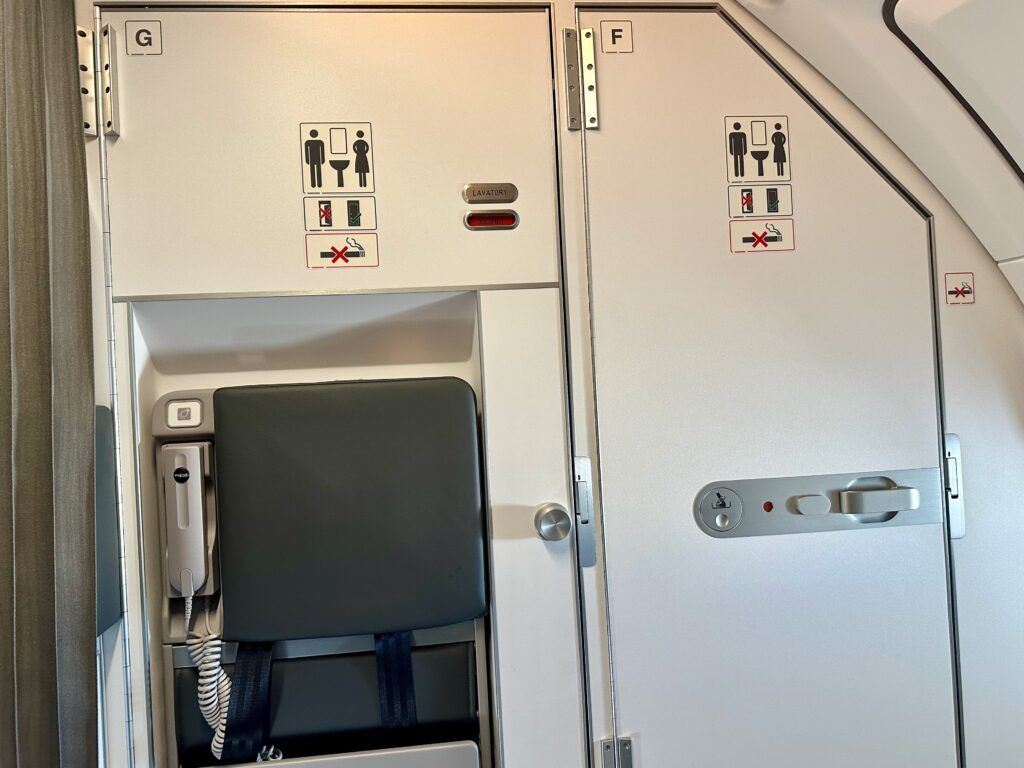
Space Flex Lavatories for Iberia’s A321XLR
Additionally, the fact that one lavatory has an attendant seat built into it means people don’t even look up to see it is a lavatory most of the time.
What is it like to fly the A321XLR for 8 hours
While I am primarily a full-service airline guy, fortunately, I’ve had the experience flying 5-hours flying Go First/Go Air between Mumbai and Phuket on their A320neo wafer thin seats in the middle seat and also fly Malaysia Airlines’ Boeing 737 between Kuala Lumpur and Delhi for a similar stage length.
I was confident about the comfort of boarding this flight but rather curious about how it would work out. Overall, the experience was very comfortable in economy class. Even those in the non-bulkhead seats said so. The space was more than good enough on this plane for people to bring out their laptops and work without having the fear of getting their laptops crushed due to the recline of the passengers ahead of them.
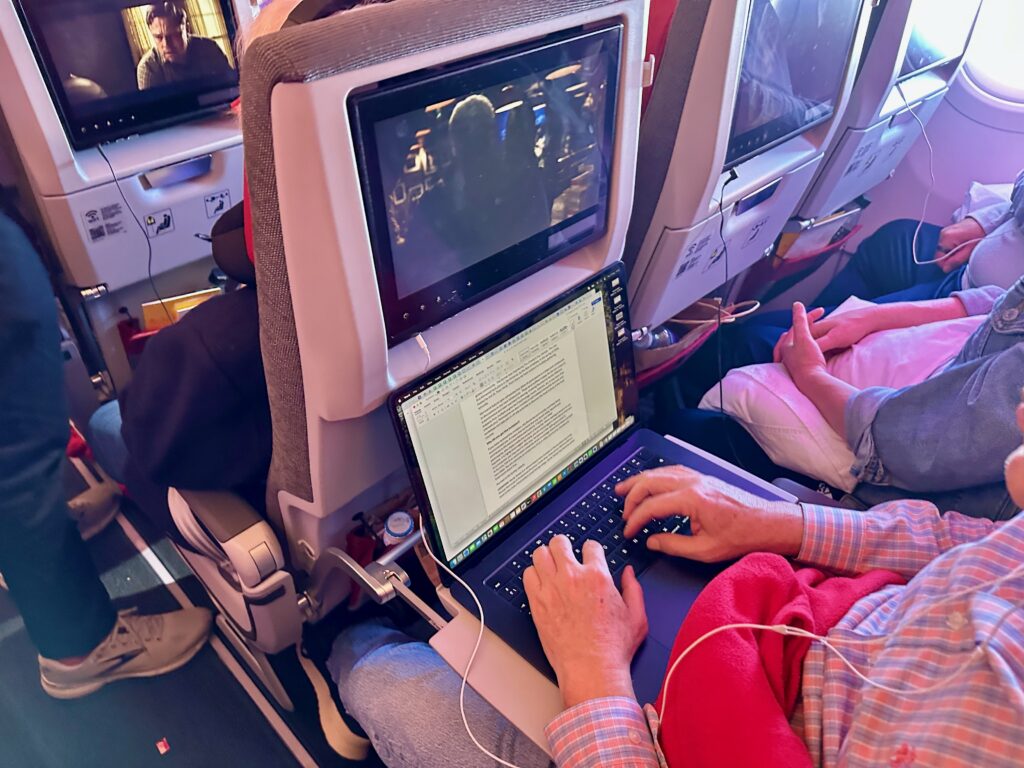
space on board the A321XLR
What the A321XLR lacks in space will make up in connectivity it will open. For instance, closer home, think about whether you want to fly Ahmedabad – Paris CDG or Pune – Frankfurt or jump the hoops to fly to another hub airport and take the plane from there. Common wisdom outside major hub centres concerns people’s preference for flying from their home airports.
Bottomline
The Airbus A321XLR represents a new era for long-haul non-stop flights that started with flights between Europe and the US but will be seen on many more new and exciting routes over the next 12-15 months. The aircraft will make possible non-hub flying, conversion of seasonal routes to year-long routes, and the build-up of frequencies on some of these routes. It is a comfortable aircraft to fly after all, and it depends on the airline to make some wise choices to bring the right passenger experience on board.
What do you think about the A321XLR given the initial information that is out there? Would you fly it?
Liked our articles and our efforts? Please pay an amount you are comfortable with; an amount you believe is the fair price for the content you have consumed. Please enter an amount in the box below and click on the button to pay; you can use Netbanking, Debit/Credit Cards, UPI, QR codes, or any Wallet to pay. Every contribution helps cover the cost of the content generated for your benefit.
(Important: to receive confirmation and details of your transaction, please enter a valid email address in the pop-up form that will appear after you click the ‘Pay Now’ button. For international transactions, use Paypal to process the transaction.)
We are not putting our articles behind any paywall where you are asked to pay before you read an article. We are asking you to pay after you have read the article if you are satisfied with the quality and our efforts.


Leave a Reply